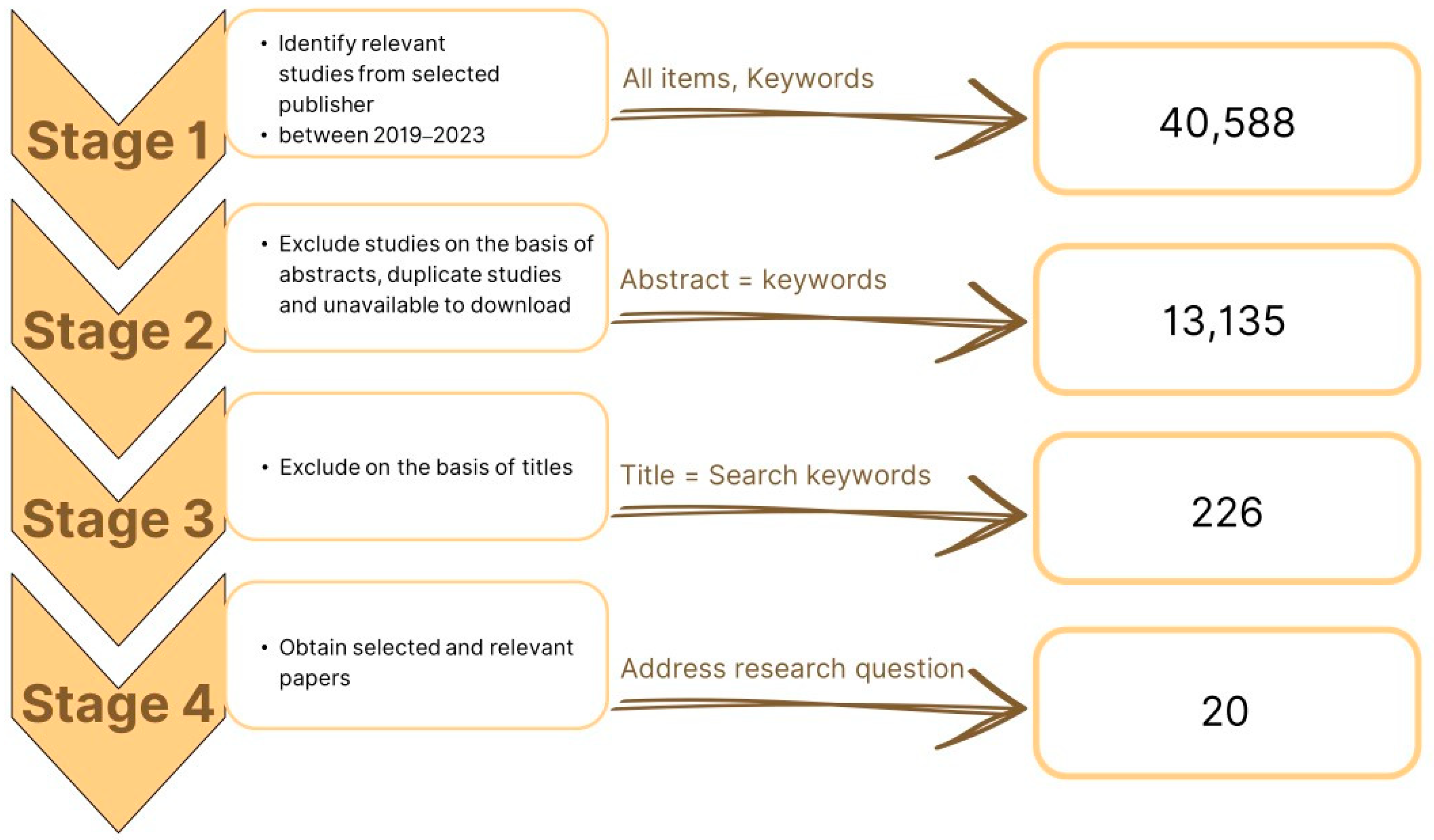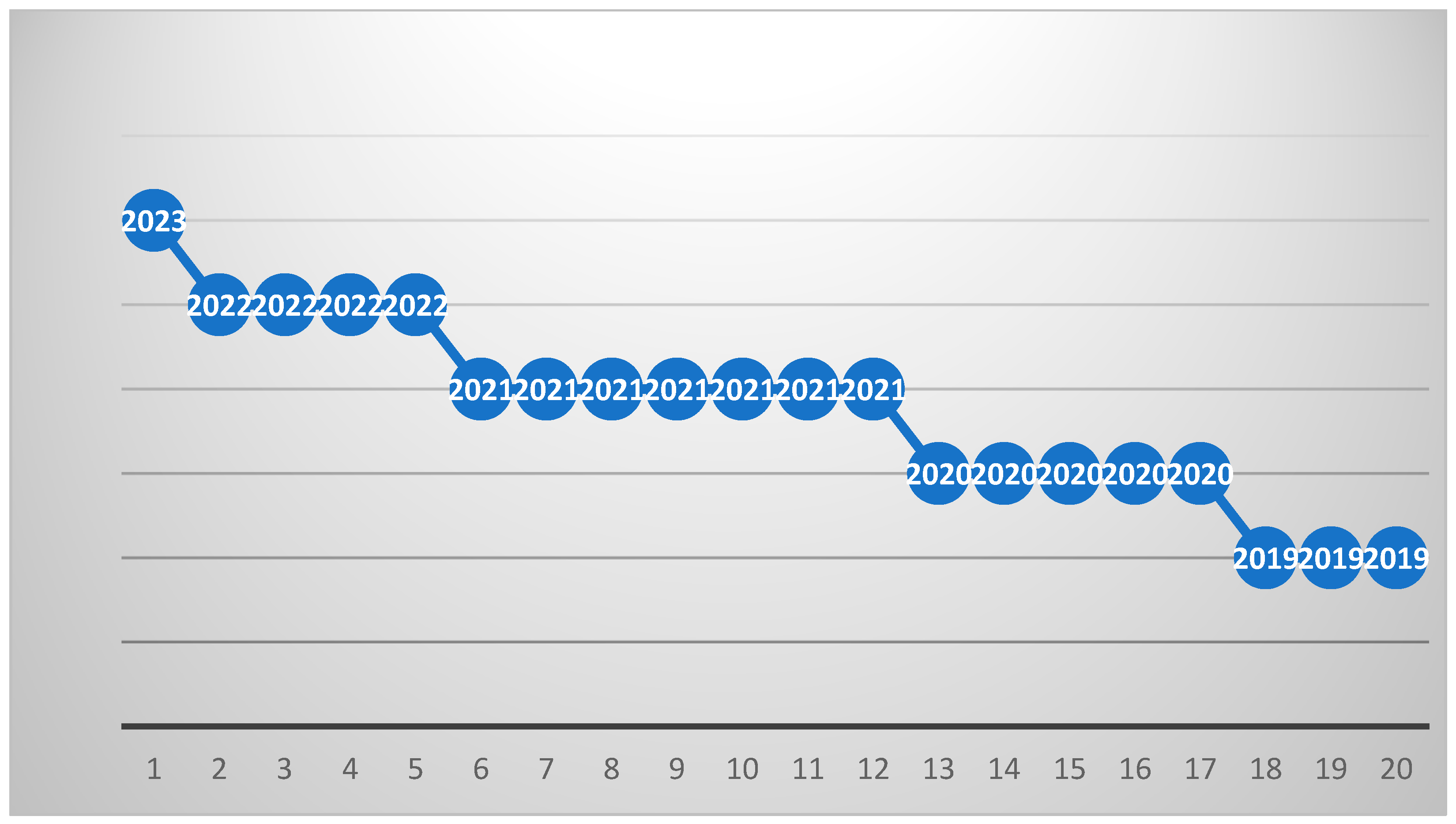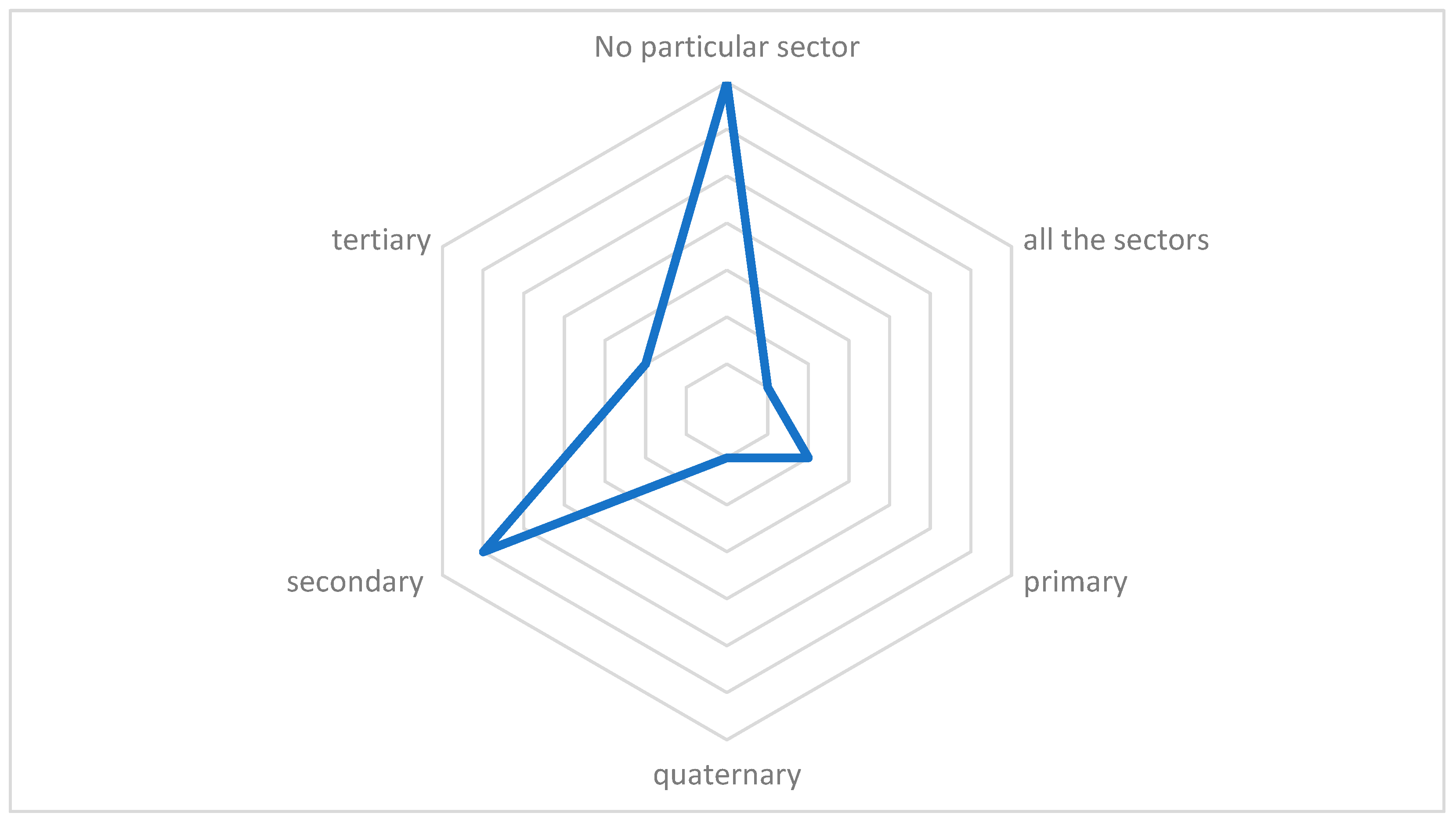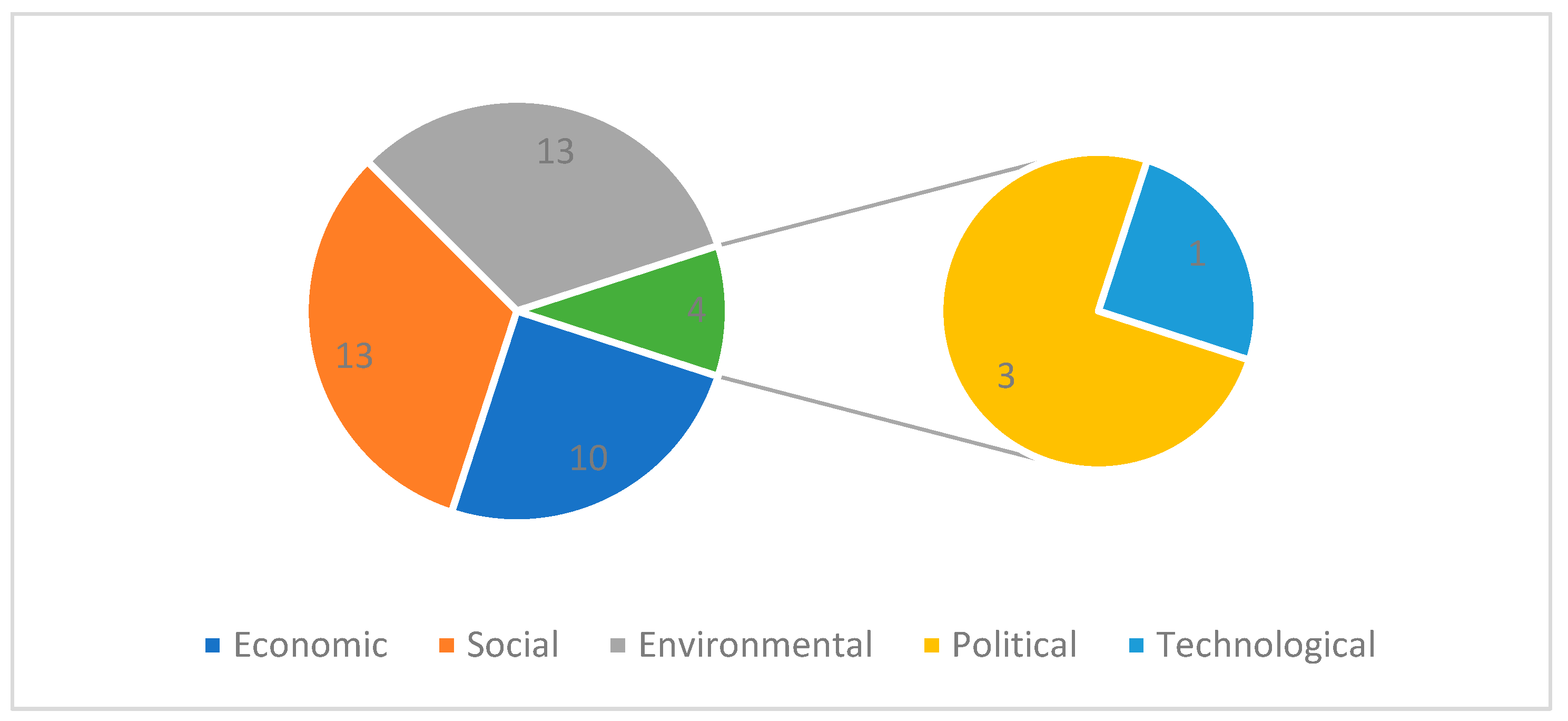Reviewing Sustainability Measurement Methods for Enterprises
Abstract
1. Introduction
2. Methodology
3. Literature Review
3.1. Criteria for Identifying Research Articles
- Sustainability; sustainable development; environmental, social and corporate governance (ESG); Sustainable Development Goals (SDGs); Global Reporting Initiative (GRI).
- Enterprise; firm; company, business, small and medium-sized enterprises (SMEs).
3.2. The Reviewed Methods for Evaluating Sustainability Levels
3.2.1. Correlation Analysis
3.2.2. Regression Analysis
3.2.3. Case Study Method
3.2.4. Descriptive Analysis
3.2.5. Cluster Analysis
4. Final Results and Discussion
4.1. Separation of Articles by Year of Their Writing
4.2. Global Distribution of Research Papers
4.3. Division by Sectors of the Economy
4.4. Size of Studied Companies
4.5. Methods That Were Used in the Analysis in the Articles
4.6. Groups of Sustainable Development Factors
5. Conclusions
Author Contributions
Funding
Institutional Review Board Statement
Informed Consent Statement
Data Availability Statement
Acknowledgments
Conflicts of Interest
References
- Gomes, S.; Pinho, M. Can We Count on the Commitment of European SMEs to Achieve SGD12? An Exploratory Study of Business Sustainability. J. Clean. Prod. 2023, 425, 139016. [Google Scholar] [CrossRef]
- Kumar, R.; Pathak, G.S. Corporate Entrepreneurship in the Pursuit of Sustainable Development: Creating a More Sustainable Future. Probl. Ekorozwoju 2022, 17, 166–177. [Google Scholar] [CrossRef]
- Ruffino, R. Sustainable Design: Aspects of Sustainable Product Development. Bioresources 2021, 16, 6548–6550. [Google Scholar] [CrossRef]
- Huang, S.Y.B.; Yu, C.C.; Lee, Y.S. How to Promote the Agricultural Company Through Environmental Social Responsibility to Achieve Sustainable Production? Front. Environ. Sci. 2022, 9, 521. [Google Scholar] [CrossRef]
- Santolaya, J.L.; Lacasa, E.; Biedermann, A.; Muñoz, N. A Practical Methodology to Project the Design of More Sustainable Products in the Production Stage. Res. Eng. Des. 2019, 30, 539–558. [Google Scholar] [CrossRef]
- Caiado, R.G.G.; Quelhas, O.L.G.; de Nascimento, D.L.M.; Anholon, R.; Leal Filho, W. Towards Sustainability by Aligning Operational Programmes and Sustainable Performance Measures. Prod. Plan. Control 2019, 30, 413–425. [Google Scholar] [CrossRef]
- Getele, G.K.; Li, T.; Arrive, T.J. Corporate Culture in Small and Medium Enterprises: Application of Corporate Social Responsibility Theory. Corp. Soc. Responsib. Environ. Manag. 2020, 27, 897–908. [Google Scholar] [CrossRef]
- Khaled, R.; Ali, H.; Mohamed, E.K.A. The Sustainable Development Goals and Corporate Sustainability Performance: Mapping, Extent and Determinants. J. Clean. Prod. 2021, 311, 127599. [Google Scholar] [CrossRef]
- Li, J.; Bouraoui, T.; Radulescu, M. On the Drivers of Sustainable Development: Empirical Evidence from Developed and Emerging Markets. Appl. Econ. 2023, 55, 6809–6821. [Google Scholar] [CrossRef]
- Muñoz-Torres, M.J.; Fernández-Izquierdo, M.Á.; Rivera-Lirio, J.M.; Escrig-Olmedo, E. Can Environmental, Social, and Governance Rating Agencies Favor Business Models That Promote a More Sustainable Development? Corp. Soc. Responsib. Environ. Manag. 2019, 26, 439–452. [Google Scholar] [CrossRef]
- Steinhofel, E.; Galeitzke, M.; Kohl, H.; Orth, R. Sustainability Reporting in German Manufacturing SMEs. Procedia Manuf. 2019, 33, 610–617. [Google Scholar] [CrossRef]
- Talbot, D.; Raineri, N.; Daou, A. Implementation of Sustainability Management Tools: The Contribution of Awareness, External Pressures, and Stakeholder Consultation. Corp. Soc. Responsib. Environ. Manag. 2021, 28, 71–81. [Google Scholar] [CrossRef]
- Awan, U.; Sroufe, R. Sustainability in the Circular Economy: Insights and Dynamics of Designing Circular Business Models. Appl. Sci. 2022, 12, 1521. [Google Scholar] [CrossRef]
- Wibowo, S. A New Sustainability Index for Evaluating the Sustainability Performance of Mining Companies. In Proceedings of the 6th International Symposium on Computational Intelligence and Design, ISCID 2013, Hangzhou, China, 28–29 October 2013; Volume 1, pp. 185–188. [Google Scholar] [CrossRef]
- Alsufyani, N.; Gill, A.Q. Digitalisation Performance Assessment: A Systematic Review. Technol. Soc. 2022, 68, 101894. [Google Scholar] [CrossRef]
- Xiao, P.; Salleh, M.I.; Zaidan, B.B.; Xuelan, Y. Research on Risk Assessment of Blockchain-Driven Supply Chain Finance: A Systematic Review. Comput. Ind. Eng. 2023, 176, 108990. [Google Scholar] [CrossRef]
- Burgers, C.; Brugman, B.C.; Boeynaems, A. Systematic Literature Reviews: Four Applications for Interdisciplinary Research. J. Pragmat. 2019, 145, 102–109. [Google Scholar] [CrossRef]
- Edwards, R. Statistics at Square One. J. Epidemiol. Community Health 1997, 51, 104. [Google Scholar] [CrossRef][Green Version]
- Çakar, K.; Aykol, Ş. Case Study as a Research Method in Hospitality and Tourism Research: A Systematic Literature Review (1974–2020). Cornell Hosp. Q. 2021, 62, 21–31. [Google Scholar] [CrossRef]
- Lestringant, P.; Delarue, J.; Heymann, H. 2010–2015: How Have Conventional Descriptive Analysis Methods Really Been Used? A Systematic Review of Publications. Food Qual Prefer 2019, 71, 1–7. [Google Scholar] [CrossRef]
- Cibulková, J.; Kupková, B. Review of Visualization Methods for Categorical Data in Cluster Analysis. Statistika 2022, 102, 396–408. [Google Scholar] [CrossRef]
- Trianni, A.; Cagno, E.; Neri, A.; Howard, M. Measuring Industrial Sustainability Performance: Empirical Evidence from Italian and German Manufacturing Small and Medium Enterprises. J. Clean. Prod. 2019, 229, 1355–1376. [Google Scholar] [CrossRef]
- Bajdor, P.; Pawełoszek, I.; Fidlerova, H. Analysis and Assessment of Sustainable Entrepreneurship Practices in Polish Small and Medium Enterprises. Sustainability 2021, 13, 3595. [Google Scholar] [CrossRef]
- Raman, R.; Subramaniam, N.; Nair, V.K.; Shivdas, A.; Achuthan, K.; Nedungadi, P. Women Entrepreneurship and Sustainable Development: Bibliometric Analysis and Emerging Research Trends. Sustainability 2022, 14, 9160. [Google Scholar] [CrossRef]
- Le, T.T. How Do Corporate Social Responsibility and Green Innovation Transform Corporate Green Strategy into Sustainable Firm Performance? J. Clean. Prod. 2022, 362, 132228. [Google Scholar] [CrossRef]
- Machado, M.C.; Carvalho, T.C.M.d.B. Maturity Models and Sustainable Indicators—A New Relationship. Sustainability 2021, 13, 13247. [Google Scholar] [CrossRef]
- Hoang Tien, N.; Ba Hung Anh, D.; Minh Ngoc, N.; City, M.; Correspondence Nguyen Hoang Tien, V. Corporate Financial Performance Due to Sustainable Development in Vietnam. Corp. Soc. Responsib. Environ. Manag. 2020, 27, 694–705. [Google Scholar] [CrossRef]
- Norese, M.F.; Corazza, L.; Bruschi, F.; Cisi, M. A Multiple Criteria Approach to Map Ecological-Inclusive Business Models for Sustainable Development. Int. J. Sustain. Dev. World Ecol. 2020, 28, 75–91. [Google Scholar] [CrossRef]
- Meiyou, D.; Ye, Y. Establishment of Big Data Evaluation Model for Green and Sustainable Development of Enterprises. J. King Saud. Univ. Sci. 2022, 34, 102041. [Google Scholar] [CrossRef]
- Bradley, P.; Parry, G.; O’Regan, N. A Framework to Explore the Functioning and Sustainability of Business Models. Sustain. Prod. Consum. 2020, 21, 57–77. [Google Scholar] [CrossRef]
- Süß, A.; Höse, K.; Götze, U. Sustainability-Oriented Business Model Evaluation—A Literature Review. Sustainability 2021, 13, 10908. [Google Scholar] [CrossRef]
- Ordonez-Ponce, E.; Clarke, A.; MacDonald, A. Business Contributions to the Sustainable Development Goals through Community Sustainability Partnerships. Sustain. Account. Manag. Policy J. 2021, 12, 1239–1267. [Google Scholar] [CrossRef]
- Rajesh, R. Exploring the Sustainability Performances of Firms Using Environmental, Social, and Governance Scores. J. Clean. Prod. 2020, 247, 119600. [Google Scholar] [CrossRef]
- Jiang, M.; Gao, Y.; Jin, M.; Liu, S. Sustainable Development of the Business Environment in Smart Cities: A Hierarchical Framework. Kybernetes 2020, 50, 1426–1448. [Google Scholar] [CrossRef]
- Ioannou, I.; Serafeim, G. What Drives Corporate Social Performance the Role of Nation-Level Institutions. J. Int. Bus. Stud. 2012, 43, 834–864. [Google Scholar] [CrossRef]







| Publishers/Screening Stage | Stage 1 | Stage 2 | Stage 3 | Stage 4 |
|---|---|---|---|---|
| MDPI | 11,294 | 2839 | 49 | 5 |
| Elsevier | 7841 | 2273 | 36 | 7 |
| Emerald Group Publishing | 3082 | 1390 | 18 | 2 |
| Taylor & Francis | 1953 | 611 | 7 | 2 |
| Wiley | 1951 | 731 | 25 | 4 |
| Group | Included Sectors |
|---|---|
| Primary | Agriculture, Forestry, Mining |
| Secondary | Manufacturing, Construction, Industrial Activities |
| Tertiary | Transportation, Healthcare, Education |
| Quaternary | Information Technology, Knowledge-Based Services |
Disclaimer/Publisher’s Note: The statements, opinions and data contained in all publications are solely those of the individual author(s) and contributor(s) and not of MDPI and/or the editor(s). MDPI and/or the editor(s) disclaim responsibility for any injury to people or property resulting from any ideas, methods, instructions or products referred to in the content. |
© 2023 by the authors. Licensee MDPI, Basel, Switzerland. This article is an open access article distributed under the terms and conditions of the Creative Commons Attribution (CC BY) license (https://creativecommons.org/licenses/by/4.0/).
Share and Cite
Serzante, M.; Khudozhnyk, A. Reviewing Sustainability Measurement Methods for Enterprises. Sustainability 2023, 15, 15514. https://doi.org/10.3390/su152115514
Serzante M, Khudozhnyk A. Reviewing Sustainability Measurement Methods for Enterprises. Sustainability. 2023; 15(21):15514. https://doi.org/10.3390/su152115514
Chicago/Turabian StyleSerzante, Milena, and Anastasiia Khudozhnyk. 2023. "Reviewing Sustainability Measurement Methods for Enterprises" Sustainability 15, no. 21: 15514. https://doi.org/10.3390/su152115514
APA StyleSerzante, M., & Khudozhnyk, A. (2023). Reviewing Sustainability Measurement Methods for Enterprises. Sustainability, 15(21), 15514. https://doi.org/10.3390/su152115514





